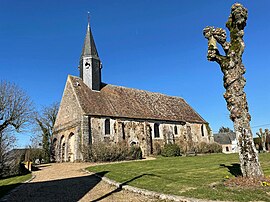Gohory | |
|---|---|
 Saint-Michel church | |
| Coordinates: 48°10′01″N 1°13′43″E / 48.1669°N 1.2287°E | |
| Country | France |
| Region | Centre-Val de Loire |
| Department | Eure-et-Loir |
| Arrondissement | Châteaudun |
| Canton | Brou |
| Intercommunality | CC du Grand Châteaudun |
| Government | |
| • Mayor (2020–2026) | François Malzert[1] |
| Area 1 | 9.47 km2 (3.66 sq mi) |
| Population (2021)[2] | 316 |
| • Density | 33/km2 (86/sq mi) |
| Time zone | UTC+01:00 (CET) |
| • Summer (DST) | UTC+02:00 (CEST) |
| INSEE/Postal code | 28182 /28160 |
| Elevation | 161–180 m (528–591 ft) (avg. 170 m or 560 ft) |
| 1 French Land Register data, which excludes lakes, ponds, glaciers > 1 km2 (0.386 sq mi or 247 acres) and river estuaries. | |
Gohory (French pronunciation: [ɡɔ.ɔʁi]) is a commune in the Eure-et-Loir department and Centre-Val de Loire region of north-central France. It lies 36 km south-west of Chartres and some 115 km from Paris.
Population
[edit]| Year | Pop. | ±% p.a. |
|---|---|---|
| 1968 | 258 | — |
| 1975 | 226 | −1.87% |
| 1982 | 223 | −0.19% |
| 1990 | 234 | +0.60% |
| 1999 | 222 | −0.58% |
| 2009 | 301 | +3.09% |
| 2014 | 328 | +1.73% |
| 2020 | 316 | −0.62% |
| Source: INSEE[3] | ||
See also
[edit]References
[edit]- ^ "Répertoire national des élus: les maires". data.gouv.fr, Plateforme ouverte des données publiques françaises (in French). 2 December 2020.
- ^ "Populations légales 2021" (in French). The National Institute of Statistics and Economic Studies. 28 December 2023.
- ^ Population en historique depuis 1968, INSEE



Well, that’s interesting to know that Psilotum nudum are known as whisk ferns. Psilotum nudum is the commoner species of the two. While the P. flaccidum is a rare species and is found in the tropical islands. Both the species are usually epiphytic in habit and grow upon tree ferns. These species may also be terrestrial and grow in humus or in the crevices of the rocks.
View the detailed Guide of Psilotum nudum: Detailed Study Of Psilotum Nudum (Whisk Fern), Classification, Anatomy, Reproduction